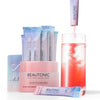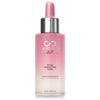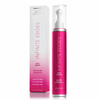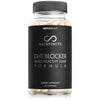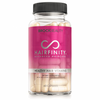
8 Ways to Tell if Your Hair Is Thinning Before It's Too Late
We all lose dozens of hair strands every day; according to the American Academy of Dermatology, an average individual loses 50 to 100 strands per day. Losing anything more than this might indicate excess shedding, which will lead to hair thinning.
Hair thinning isn't a widespread hair loss, and it just causes some parts of your head to have sparse hair.
A dermatologist has confirmed that hair thinning affects women emotionally and psychologically, but society often shuns the issue. She added that women feel embarrassed when they experience hair loss, even though it's a common condition.
Studies have shown that 38% of women will experience hair thinning. Please don't panic; it doesn't happen overnight, so you can identify the causes and choose the best treatment measure.
If you're part of the team "my hair is so thin I can see my scalp," then this guide is for you. Here, we'll discuss hair thinning, its causes, ways to tell if your hair is thinning, and the best treatment methods. Let's get to it!
What is Hair Thinning?
Hair thinning is increased hair shedding, receding hairline, and a more visible scalp. The hair follicles start to shrink, which leads to the growth of thinner, smaller, and more fragile hair.
The most common type of hair thinning in females is androgenetic alopecia, also referred to as pattern hair loss. It is caused by aging, changes in levels of androgens, and a family history of baldness.
The earlier you notice your hair is thinning, the better! Since the earlier the problem is realized, the easier its treatment will be. Below are the top eight ways to tell if your hair is thinning
Eight Ways to Tell If Your Hair Is Thinning
There are few signs of hair loss or hair thinning. If you wish to reverse hair thinning, one of the best ways to accomplish this is via early treatment. Therefore, consider seeing your physician for proper treatment once you discover one or more of the signs mentioned below.
- Bald Patches
If you've noticed that you're shedding more hair strands, check out for noticeable bald patches. If you're experiencing excessive hair loss, this might indicate that your hair is thinning. You may not see the bald patches at times, but you'll see your scalp peeking out when you tie your hair into a ponytail.
- Lighter Hair
After losing excess hair, you might notice your hair has lost its weight. This is most noticeable in people wearing ponytails.
The ponytail will feel lighter, look smaller and shorter, and you'll have to loop your ribbon several times more than you do to keep the hair in place. This can be another warning sign that your hair is thinning.
- A More Prominent Forehead
Another way to tell if your head is thinning is a receding hairline. This, however, is most common in men. It makes the forehead look more prominent and bolder.
- More Hair On the Pillow Or Comb
Seeing a few hairs on your pillow, comb, or shower drain doesn't indicate hair thinning. Our scalp contains more than 100,000 hair, and we lose about 50 to 100 strands daily. And that's the natural life cycle of hair - they continually grow, stop and shed out.
But if you notice more hair on your pillow or comb, it means you're shedding more hair than usual, and it might be a sign your hair is thinning.
- More Scalp Sunburn
It's normal to experience minor sunburn on the scalp. But a severe scalp sunburn will only occur when your hair is thinning. In this case, you'll notice your scalp looking burnt. Hurry up and consult your doctor, as it might be a warning sign of hair thinning.
- When You Can't Style Your Hair like Before
Another way to know that your hair is thinning is when you can't style your hair the same way you've done it before. As your hair thins, you won't be able to do different styles, and you'll need to start styling it to cover the thinning areas.
- When Your Hair is Coming Out in Clumps
Another noticeable sign of hair thinning is how hair is falling out, especially if it's coming out in clumps. An excellent way to know this is by running your fingers through your hair and seeing if clumps instead of strands are coming out. You can also notice hair clumps during the shower or when you comb it.
- Itchy Scalp
An itchy scalp isn't a direct symptom of hair thinning, but it can signify other conditions, like too much sebum on the scalp and fungal infections. Frequent scratching of the head due to an itchy scalp can cause excess hair fall. If you're experiencing severe itching on your scalp, consult a dermatologist.
If you notice any of these signs, see a doctor for a proper diagnosis to know the cause of hair loss.
Causes of Hair Thinning
As earlier said, some degree of hair loss is normal. But new hair is constantly growing to replace the lost one.
However, if a person notices significant hair loss, bald patches, and hair clumps, they may be experiencing hair loss. According to the American Academy of Dermatology (AAD), most hair loss problems can be cured.
Below we're going to look at the possible causes of hair thinning
- Diet
The body needs nutritious food to maintain healthy hair follicles and create new hair strands. Vitamins and other micronutrients are essential in maintaining healthy hair follicles, while protein is a vital component of hair.
Deficiency in the above nutrients can cause hair thinning. Proper nutrition can help promote the growth of healthy, strong, and beautiful hair. Malnutrition causes hair loss, dandruff, dull appearance, and dry hair.
- Stress
Significant stress for a long time causes thinning of hair. This is also known as Telogen Effluvium.
Stress causes an increase in the release of stress hormones like cortisol. These hormones in high amounts may kill off new hair stands trying to grow.
Once the stress is reduced, your hair will return to its average volume and texture.
- Lifestyle Habits
One of the leading causes of hair thinning is lifestyle habits. These include over-treating your hair with relaxers, perms, hair colors, using strong hair chemicals, and wearing a tight hairstyle that can pull on your hair and break it from its follicles, leading to hair thinning.
- Pregnancy
Another cause of hair thinning is pregnancy. Many pregnant women complain to their physicians, saying, "my hair is so thin I can see my scalp." This shouldn't panic you as the hair will grow back before or after delivery if an underlying medical condition does not cause the hair loss.
- Deficiency in Vitamin D
Vitamin D boosts hair growth by stimulating hair follicles. When a person lacks vitamin D, they might experience hair thinning, among other symptoms.
Some studies have related Vitamin D to Alopecia, a leading cause of hair loss.
- Alopecia Areata
This is a common disorder characterized by hair loss in bald patches on the head. It also affects the beard, eyebrows, eyelashes, and other hair growth areas.
The leading causes of alopecia are genes and environmental factors. Americans have a high chance of developing this condition.
Doctors effectively treat Alopecia Areata with injection into the scalp.
Other less common causes of hair thinning are skin disorders, eating disorders, immune system deficiencies, drastic weight loss, hormonal changes, and pulling your hair with your hands.
Treatment of Hair Thinning
Most cases of hair thinning can be easily treated at home. Below are some practical ways to treat hair thinning, but talk to your doctor before starting treatment.
- Minoxidil
This compound comes in 2 to 5 percent of hair thinning problems. It is applied directly to the affected area, and it is regarded as a valuable treatment for Androgenic Alopecia.
Minoxidil is the only FDA-approved treatment for female pattern hair loss, and it can be taken without a prescription.
If you start taking Minoxidil, you'll have to keep taking it. Else, hair thinning will occur. Some of its side effects are excessive hair growth and itchy skin.
A drug used as an alternative to Minoxidil is Finasteride which is mainly used by men who aren't successful with Minoxidil. It is an oral medication, and its side effects include decreased libido and gynecomastia.
- Spironolactone
Also known as Aldactone, this drug is prescribed to patients having thin hair due to androgen production. The water pill is also an anti-androgen.
In women, it reduces hair loss, thinning of hair, and hormonal imbalance disorders.
- Vitamin B7
Vitamin B7 is a water-soluble nutrient naturally found in food substances like lentils and nuts. Vitamin B7 deficiency is mainly caused by malnutrition, but many supplemental forms of the nutrient are available in markets.
The nutrient is known to increase energy and break down body enzymes, but there's little evidence that it helps in reducing hair thinning.
- Vitamin D
Vitamin D is a fat-soluble nutrient that helps the body retain calcium and phosphorus. Deficiency in this nutrient can cause hair thinning and hair loss.
You get most of your vitamin D from diet and exposure to sunlight. Diets include high vitamin vitamins, egg yolk, fatty fish, milk, cereals, cheese, and liver.
Taking vitamin D-rich diets or vitamin D supplements can help treat hair thinning and hair loss.
- Multivitamins
The growth of healthy hair depends on good health. When a person is malnourished, hair may fall to grow from follicles. A daily multivitamins dosage will provide hair with folic acid, iron, zinc, and other required multivitamins.
However, you should avoid taking extra vitamins if you aren't low on them. This is why it's vital to undergo a blood test to know whether you're deficient in any vitamin before taking multivitamins.
Getting the required multivitamins you need will help in treating hair thinning. At the same time, excess multivitamins might cause harm to your health.
Try a multi-vitamin designed specifically for thinning hair, like HAIRFINITY DHT Blocker and Healthy Hair Formula. This enriched formula features Saw Palmetto, a powerful DHT blocker, clinically proven to help stop hair loss and promote hair regrowth. Also includes biotin, iron and zinc, which promotes the growth and maintenance of existing hair. These hair loss prevention vitamins are safe and effective for men and women.
- Essential Oils
Essential oils are obtained from certain plants and are used as remedies for many disorders. Few people have tried using essential oils to treat hair thinning, and the result was a success. Though there's little research to back up how effective these oils are, they're mostly harmless.
Some studies have shown that Rosemary oil increases blood flow, increasing scalp health. A healthy scalp will stimulate the growth of healthy and full hair.
A trial in 2015 compared 2% minoxidil and Rosemary for hair thinning, and both participants experienced significant hair growth after six months of usage.
Some individuals have also used lavender oil to treat pattern baldness, though research proves this.
When using essential oils, dilute them will carrier oils like jojoba oil or coconut oil to avoid irritation.
- Scalp Massage
Scalp massage is possibly the easiest and cheapest way to achieve thicker and fuller hair. It costs no dime, and it's harmless if done correctly.
Clean your hair, then gently apply pressure on your head with your fingertips. This encourages blood flow, which boosts scalp health and stimulates the growth of healthy, thicker hair. You can also use a compact scalp massager for proper massaging and removal of dead skin.
Conclusion
Although it's normal to lose dozens of hair strands daily, it's advisable to speak to your doctor if you notice shedding excess hair.
Thinning hair can grow back depending on the cause. If it's caused by lifestyle habits, stress, pregnancy, nutrient deficiencies, and other non-genetic causes, the hair will grow back.
If you're not sure of the cause of your hair thinning, see a doctor, especially if you've made a change in your diet or you've started taking supplements. The doctor will determine whether you're seeing a dermatologist or you're going to cut off some diets or supplements.
There are many ways to treat hair thinning, from medications to home remedies. Most of these methods are harmless if done in the right way. However, it would help to talk to your doctor before starting any medication.

















